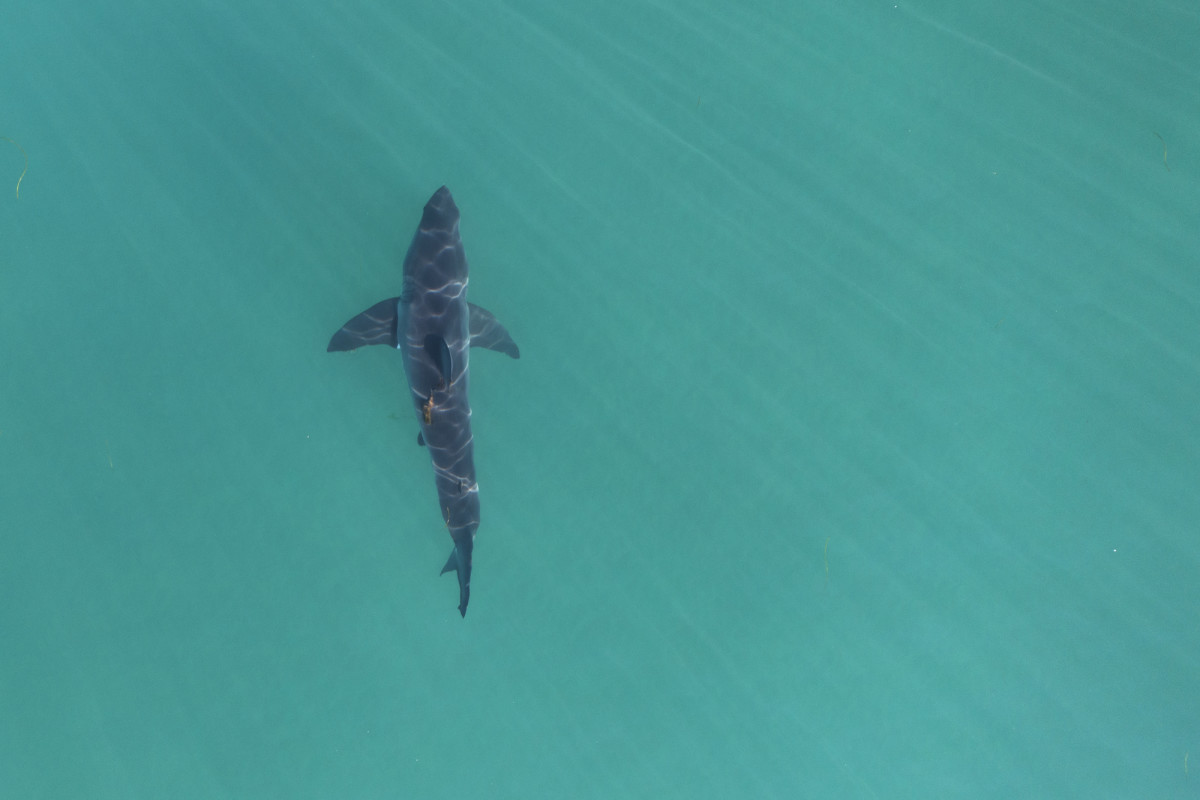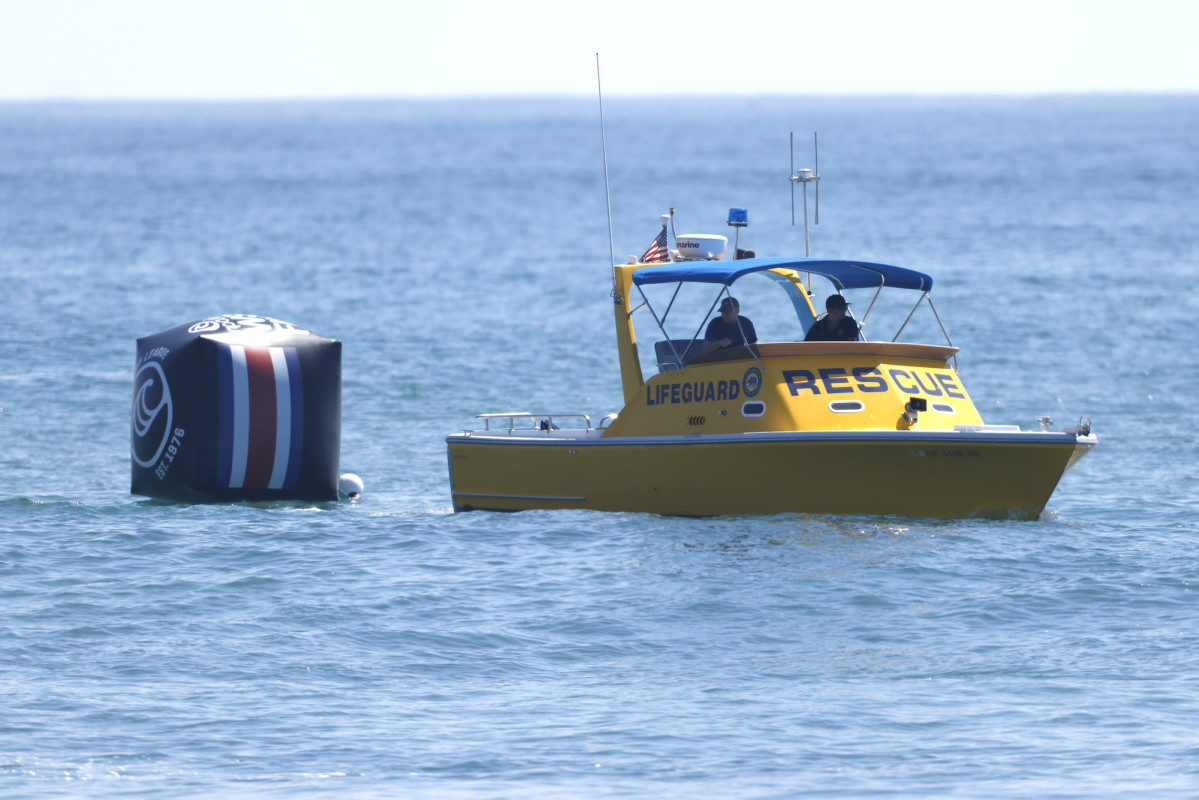
Photo: Kevin Carter/Getty Images
Summer in Southern California is here, and that means a few things – hordes of beachgoers flocking to the sand, out-of-school groms and saltwater-starved inlanders inundating lineups, the occasional flurry of south swell activity, and…sharks.
Like clockwork, and like the increased presence of humans, young great white sharks are common in summertime Southern California waters. And that’s for a handful of reasons – the young ones like the warmer temperatures, they have access to a buffet of their favorite foods (sting rays, small fish, etc.), and it’s in their realm of typical migratory patterns (south of the border for winter, SoCal for summer; although that’s starting to shift with climate change).
So, with peak summer nigh, instead of a surf forecast for the season, we hit up Cal State Long Beach Shark Lab Director, Dr. Chris Lowe, for a “shark forecast.” Scroll on for our chat.

Photo: Sean M. Haffey/Getty Images
Hey Chris. First off, how’s everything going over at the Shark Lab?
Things are going well, but we run out of money in September. Our state funding dries up. So, we’ve gotta find money somewhere else to keep going.
Related: Great White Sharks Near Surfers 97% of the Time in CA Waters, Study Shows
With the recent shark encounters and attacks in Southern California – first at T-Street, then in Del Mar – is this anything out of the ordinary? Is there an increase this season?
I don’t think we’re seeing an increase. These sorts of events happen sporadically. What’s really interesting is that sometimes they happen fairly close together, time-wise. But we can’t identify any patterns. If you look over the course of a year, in California, we average about three bites.
The main thing is, we have to take into account the amount of people going in the water. That is increasing. For a lot of surfers, especially in Southern California, if they look at lineups compared to 10 or 15 years ago, they know. The lineups are getting bigger and bigger, there’s more people, more competition. There’s definitely more ocean activity today than before. We’re just putting more people into the water, and that will continue to increase with climate change.
Back in 2017, there was seemingly a lot of shark activity in Southern California. There was the attack on a swimmer at San Onofre, multiple shark breaches at Trestles, and more. From your findings, are things cyclical in terms of shark action? Could this be a repeat of 2017?
We can’t discern that just yet. We’ve been doing this for about 15 years. What I can tell you is that over 15 years, we’ve seen an increase in the number of sharks. The number of nearshore juvenile aggregation sites is increasing. We now see more aggregations, and the aggregations are bigger. We attribute that to the fact that there’s just more white sharks. Protection and conservation, those things have helped.
What we don’t know is how El Niño and La Niña patterns influence those abundances off our beaches. We’re going to need another 10 years to look at those patterns. We’ve only been through one good El Niño, La Niña season. So, we need to see how those four-to-five year cycles begin to influence how many sharks are at the beaches, how long they are spending there, if they migrate south to Baja, or are they over-wintering. That’s something we’re seeing more of – these juvenile white sharks are over-wintering. They’re staying at these beaches all year round.
We’re trying to figure out how these climate patterns effect shark abundance. We know it influences surfing and beach activity. During El Niño, we have really hot summers, and a lot more people are going to the beach. Then, of course, we also get a predominance of south swells, and that brings a lot more people, especially surfers, to the beach. But do these weather patterns effect shark abundance? It looks like they might.
San Onofre is a known juvenile white shark hotspot. So are a few other spots in San Diego County. Are there other hotspots emerging this season?
It used to be that white shark nurseries were relegated to Southern California. Point Conception was the northern limit. Then, starting in 2015, there’s a new nursery that’s formed in Santa Cruz. That nursery is still ongoing; they had a ton of sharks up there this year. That’s something that we attribute to climate change. The young white sharks prefer those warm conditions.
In terms of adults, we’re starting to see more of ‘em in certain locations. Particularly, Santa Barbara. I think that has to do with the fact that the Channel Islands are only 15 miles away. The ones that we’ve tagged, we see them bounce between Santa Barbara, the Channel Islands, Morro Bay, Pismo…they pop around that general area. They’ll pass through along the coast, but they don’t tend to spend a lot of time there.
Speaking of the Shark Lab losing funding, without the proper support, what could this mean for surfers, swimmers, beachgoers, etc.?
We’ve made pretty good gains in the last six years in terms of what we’ve learned, and how we get that information out to the public. For example, our drone study that we published last year. That got a huge amount of attention, because it quantified for the first time how often white sharks are near people. And that’s pretty much every day at aggregation sites. Yet, people aren’t being bitten every day. So, that was really important. It showed people that sharks are always out there; they can’t see them always; but we see them from the air.
That is a clear example of the progress we’ve made. Now, we’ve got to understand how climate patterns are going to change where sharks show up, and how much time they’re going to spend there. That’s the next big step. We’re seeing some sharks hang out at the same spots for eight months. So, the question is: What’re they eating? From our diet study, we found that there are fewer sting rays where there are fewer sharks. So, the sharks are eating those things down.
One of the things we looked at was lifeguard sting ray injury records. When there was an aggregation, we expected sting ray injuries to go down. These white sharks love eating round sting rays. More sharks, less sting rays, right? But it actually did the opposite; it went up. What we think happened was that the sharks pushed the sting rays even closer to the shoreline. Waders were more likely to encounter them.
These are just a few examples of what we’re finding. And with a few more years of funding, hopefully, we can answer some of these bigger, burning questions. If we keep getting the data we’re getting, I foresee us being able to make weekly shark forecasts at surf spots.
The latest study from Shark Lab technician, Emily Spurgeon, found that sharks – like surfers and swimmers – prefer shallow, warm water. Why is that?
White sharks are different from many of the other species, in that they’re warm-bodied. As long as they’re swimming, they can keep their body core warmer than the water. The young ones, however, they can’t keep the heat very well. So, that’s why they seek out warm conditions. Those warmer conditions speed up their metabolism, there’s food there, and that makes it a good nursery.
Related: Great White Sharks Prefer Warm, Shallow Water…Just Like You!
Based on your research, it seems like, despite all the activity, surfers and swimmers should NOT be overly alarmed. Is that still the case? Why?
Based on our data, that’s true. When you think about how many people are in the water in Southern California on a daily basis – many of them at these aggregation sites, like Del Mar and Torrey Pines – and there are dozens of cases every day, when a white shark is swimming underneath the surfer, yet still, bites are really rare. So, if you look at the numbers, your probability is really low. We are literally talking about millions of people.
Another thing we’re looking at, is that sharks are around these people all the time, but they treat them like flotsam. They don’t see humans as food, they don’t pose a threat, and they typically just ignore them. Then we’re wondering: Maybe it’s a good thing that people are around sharks all the time, because it’s helping sharks to identify those objects as people. Not food, not a threat. There should be, like, a bite a month. But there isn’t. Why? We’re studying that.
What can surfers do if they encounter a shark in the lineup?
If a shark wants you to see it, it will swim right in front of you. A lot of the time, they’re down deeper, out of sight. And a lot of the time, they’ll get close, realize it’s a human, and go, ‘this isn’t what I want,’ then bail. Most of the time they completely ignore people.
I always tell people: If you see a shark, keep an eye on it. Turn your board towards it, so the nose of your board acts like the head of animal. Make that shark know it’s been seen. Then quite often, they just take off. If one gets really close, give it a good pop. Hit it in the nose.
For more on helping the Shark Lab sustain funding, check out their website.

